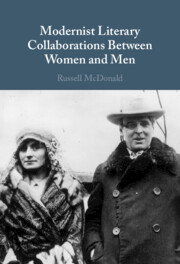Book contents
- Modernist Literary Collaborations Between Women and Men
- Modernist Literary Collaborations Between Women and Men
- Copyright page
- Dedication
- Contents
- Figures
- Acknowledgments
- Abbreviations
- Introduction
- Chapter 1 Imagining Two as One: Collaboration and the Discourse of Sex Relations in Early Modernism
- Chapter 2 The Discord Aesthetic in D. H. Lawrence’s Collaborations with Women
- Chapter 3 “The Fight to Be Affectionate”: Textual Intimacy and the Drive to Animate Marriage
- Chapter 4 “The Yolk and White of the One Shell”: Modernism’s Androgynous Textual Bodies
- Chapter 5 Conclusion: Being a Genius Together
- Notes
- Works Cited
- Index
Chapter 5 - Conclusion: Being a Genius Together
Published online by Cambridge University Press: 20 October 2022
- Modernist Literary Collaborations Between Women and Men
- Modernist Literary Collaborations Between Women and Men
- Copyright page
- Dedication
- Contents
- Figures
- Acknowledgments
- Abbreviations
- Introduction
- Chapter 1 Imagining Two as One: Collaboration and the Discourse of Sex Relations in Early Modernism
- Chapter 2 The Discord Aesthetic in D. H. Lawrence’s Collaborations with Women
- Chapter 3 “The Fight to Be Affectionate”: Textual Intimacy and the Drive to Animate Marriage
- Chapter 4 “The Yolk and White of the One Shell”: Modernism’s Androgynous Textual Bodies
- Chapter 5 Conclusion: Being a Genius Together
- Notes
- Works Cited
- Index
Summary
Chapter 5 considers the implications of modernist efforts to rethink notions of gender and creative autonomy for our understanding of genius. Although some writers and artists imagined androgyny as something a man and woman could achieve together, the same does not appear to have been true of genius, which remains for the modernists a phenomenon exhibited or embodied by individuals. I contend that the modernists’ own practice of cross-sex collaboration challenges this conception, as evidenced by two examples: the play Cathleen ni Houlihan, by W. B. Yeats and Lady Gregory, and the novel Under the Volcano, written by Malcolm Lowry with significant input from his second wife, Margerie Bonner Lowry. Neither of these masterpieces could have been realized by just one of its coauthors alone, yet no member of either couple thought of that couple itself as “a genius.” This limitation on the conception of genius came with significant personal costs and misrepresents the true nature of the writers’ powerful displays of joint creativity. Genius, I conclude, is not solely the provenance of individuals but an invaluable human capacity that can draw strength from both male and female participation.
- Type
- Chapter
- Information
- Modernist Literary Collaborations between Women and Men , pp. 205 - 223Publisher: Cambridge University PressPrint publication year: 2022

